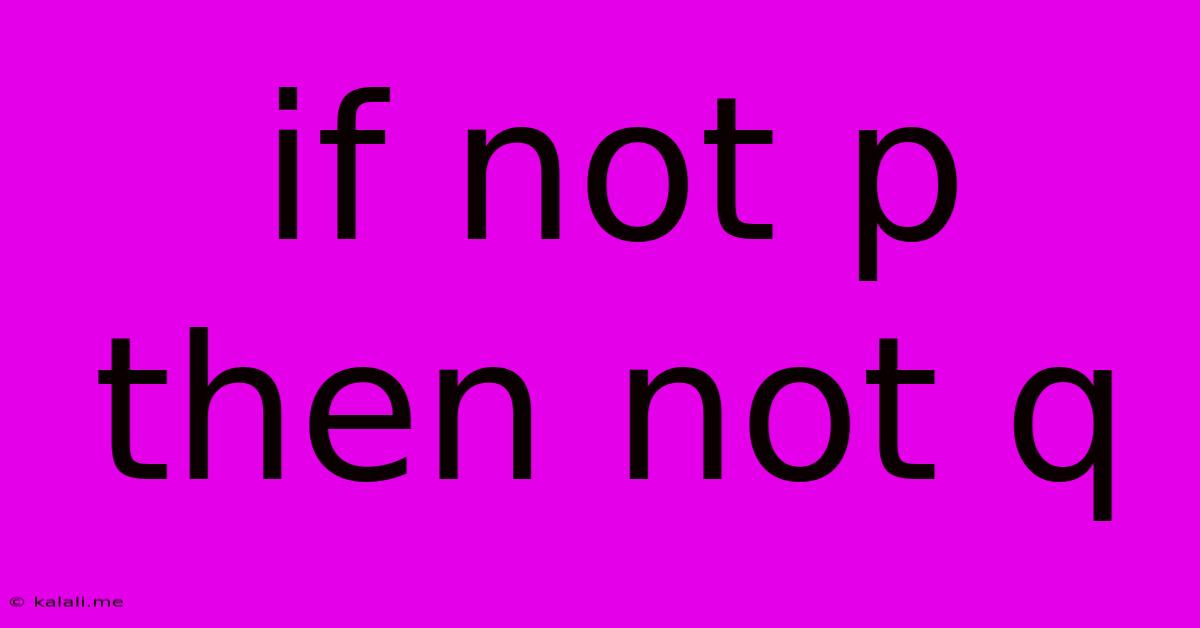If Not P Then Not Q
Kalali
Jun 01, 2025 · 3 min read

Table of Contents
Understanding the Logic of "If Not P, Then Not Q"
This article explores the logical statement "If not P, then not Q," also known as the contrapositive. Understanding contrapositives is crucial in logic, mathematics, and even everyday reasoning. We'll break down what it means, how it relates to other logical statements, and provide examples to solidify your understanding. This is a key concept for anyone looking to improve their critical thinking skills and logical reasoning abilities.
What is the Contrapositive?
The contrapositive of a conditional statement "If P, then Q" (symbolized as P → Q) is "If not Q, then not P" (¬Q → ¬P). The original statement and its contrapositive are logically equivalent; they always have the same truth value. In simpler terms, if the original statement is true, its contrapositive is also true, and vice versa. The statement "If not P, then not Q" (¬P → ¬Q) is the inverse of the conditional statement and is not logically equivalent to the original statement.
Understanding the Relationship to Other Logical Statements
Let's consider the relationship between the original conditional statement and its contrapositive, inverse, and converse:
- Original Statement (P → Q): If P, then Q.
- Contrapositive (¬Q → ¬P): If not Q, then not P. (Logically equivalent to the original statement)
- Converse (Q → P): If Q, then P. (Not logically equivalent to the original statement)
- Inverse (¬P → ¬Q): If not P, then not Q. (Not logically equivalent to the original statement)
Examples to Illustrate the Concept
Let's solidify our understanding with some examples:
- Original Statement: If it is raining (P), then the ground is wet (Q).
- Contrapositive: If the ground is not wet (¬Q), then it is not raining (¬P). This is logically equivalent to the original statement.
- Converse: If the ground is wet (Q), then it is raining (P). This is not always true; the ground could be wet for other reasons (e.g., a sprinkler).
- Inverse: If it is not raining (¬P), then the ground is not wet (¬Q). This is not always true; the ground could still be wet from previous rain.
Another Example:
- Original Statement: If a number is divisible by 4 (P), then it is divisible by 2 (Q).
- Contrapositive: If a number is not divisible by 2 (¬Q), then it is not divisible by 4 (¬P). This is logically true.
- Converse: If a number is divisible by 2 (Q), then it is divisible by 4 (P). This is not always true (e.g., the number 6).
- Inverse: If a number is not divisible by 4 (¬P), then it is not divisible by 2 (¬Q). This is not always true (e.g., the number 6).
Practical Applications
Understanding contrapositives is valuable in various fields:
- Mathematics: Proving theorems and solving logical puzzles.
- Computer Science: Developing algorithms and debugging code.
- Everyday Reasoning: Making sound deductions and avoiding logical fallacies.
Conclusion
The contrapositive, "If not Q, then not P," is a powerful tool for logical reasoning. Its logical equivalence to the original conditional statement allows us to rephrase statements in a way that can be easier to understand and work with. By understanding the relationship between the original statement, its contrapositive, converse, and inverse, we can significantly improve our critical thinking and problem-solving skills. Remember to carefully consider the implications of each statement to avoid logical errors.
Latest Posts
Latest Posts
-
Meaning Of Blue Color In The Bible
Jun 02, 2025
-
Jest Modulenamemapper Could Not Locate Module Mapped As
Jun 02, 2025
-
Why Does Water Evaporate At Room Temperature
Jun 02, 2025
-
Furnace Blowing Hot Then Cold Air
Jun 02, 2025
-
Toro Lawmower Running At Hslf Speed
Jun 02, 2025
Related Post
Thank you for visiting our website which covers about If Not P Then Not Q . We hope the information provided has been useful to you. Feel free to contact us if you have any questions or need further assistance. See you next time and don't miss to bookmark.